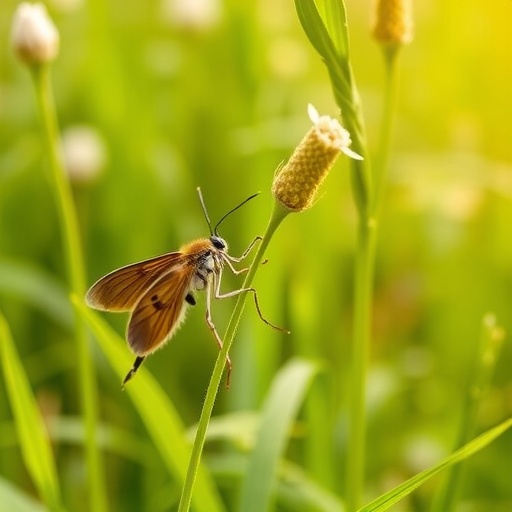In a groundbreaking study published in the journal ACS Sustainable Chemistry and Engineering, researchers from São Paulo State University (UNESP), the State University of Campinas (UNICAMP), and the Federal University of São Carlos (UFSCar) in Brazil have unveiled innovative ways to harness lignin, a complex organic polymer traditionally treated as industrial waste, to enhance the performance of herbicide-delivering nanoparticles. Their pioneering work presents lignin not merely as a byproduct but as a valuable, multifunctional biomaterial with potential to revolutionize sustainable agriculture.
Lignin, a crucial structural component embedded within plant cell walls, has long been recognized for its antioxidant properties and abundance in plant biomass. Despite its ubiquity, lignin remains underexplored, predominantly considered a residual waste stream from the pulp and paper industries. Motivated by the desire to transform this abundant natural resource into a sustainable asset, the research team spearheaded by Professor Leonardo Fraceto embarked on a project to elucidate how lignin fractions can be strategically utilized to optimize nanoparticle-based delivery systems for agrochemicals.
The research journey began with the extraction of lignin from Eucalyptus urograndis, a hardwood species highly prevalent in Brazil. Utilizing an environmentally benign method employing acetic acid as a solvent, the team fractionated lignin into discrete portions with distinct molecular structures and chemical characteristics. This green extraction approach enabled the isolation of lignin fractions exhibiting variations in phenolic content, molar mass, and thermal resilience, setting the stage for fine-tuning nanoparticle functionalities.
Subsequent synthesis of nanoparticles integrated the widely used herbicide atrazine, known for its efficacy in weed control but also scrutiny due to environmental concerns. By encapsulating atrazine within polycaprolactone (PCL) nanoparticles stabilized by specific lignin fractions, the researchers meticulously analyzed the morpho-chemical behavior of these constructs through advanced physical, chemical, and thermal characterization techniques. The findings revealed that the distinct lignin fractions imparted varied stabilization effects, influencing nanoparticle formation, stability, and release kinetics.
The study demonstrated that certain lignin fractions endowed nanoparticles with enhanced photostability, effectively protecting the polymeric matrix from ultraviolet radiation-induced degradation. This is a critical advancement since photodegradation limits the useful life and functional efficacy of agrochemical formulations in field conditions. Meanwhile, other lignin fractions facilitated controlled release behavior, acting as stabilizers that modulate the diffusion of active herbicidal compounds, thereby improving the precision and sustained impact of the treatment.
This dual functionality of lignin fractions underscores the polymer’s unique versatility, highlighting its capacity to function simultaneously as a photoprotectant and a release modulator. This bifunctional role not only elevates the performance metrics of nanoparticulate agrochemicals but also supports environmental safety by minimizing off-target dispersion and reducing the frequency of chemical applications.
Nonetheless, the researchers acknowledge significant challenges inherent in the structural variability of lignin, which can adversely impact consistency and reproducibility in nanoparticle synthesis and resulting efficacy. Addressing this molecular heterogeneity necessitates a deeper understanding of lignin chemistry and standardized processing techniques to ensure reliable performance across formulations.
In practical applications, the lignin-stabilized atrazine nanoparticles showcased remarkable herbicidal activity against pernicious weeds such as black jack (Bidens pilosa L.) and green pigweed (Amaranthus viridis L.). These results signify meaningful strides towards sustainable pest management solutions that leverage waste biomass derivatives, aligning agricultural practices with ecological stewardship and economic viability.
From a broader perspective, the study not only highlights lignin’s transformative role in nanotechnology-enhanced agrochemicals but also embodies the principles of the bioeconomy by converting an underutilized byproduct from forestry into a high-value input. This innovation bridges material science, green chemistry, and agricultural technology, setting a precedent for future interdisciplinary collaborations focused on environmental sustainability.
The environmental implications of this research are profound, providing a tangible pathway to reduce reliance on synthetic surfactants and nonrenewable materials in agrochemical products. By incorporating lignin fractions that inherently possess antioxidant and stabilizing properties, the formulations markedly reduce ecological footprints and mitigate adverse effects on non-target organisms.
Furthermore, the adoption of such green nanoparticle systems opens new frontiers in precision agriculture, enabling controlled release mechanisms that improve herbicide efficiency while diminishing chemical runoff and soil contamination. These advancements resonate with global efforts to develop environmentally benign and socially responsible agricultural practices in face of escalating climate challenges.
Professor Fraceto, reflecting on the study’s impact, emphasized the innovative integration of a simple, eco-friendly process with an abundant national resource, highlighting its significance in fostering a circular economy. Such developments demonstrate how targeted material customization can unlock new functionalities that address real-world problems, fostering sustainable growth within the agrochemical industry.
In conclusion, this multidisciplinary research contributes a compelling argument for reimagining lignin’s utility beyond its traditional marginal status. It paves the way for scalable, sustainable agrochemical formulations that better address environmental concerns, enhance efficacy, and exploit the full potential of natural polymers, heralding a new era of green innovation in agriculture.
Subject of Research: Utilization of lignin fractions as dual-function stabilizers for herbicide nanodelivery systems
Article Title: Lignin as a Dual-Function Stabilizer for Protecting PCL Nanoparticles from Photodegradation and Enhancing Atrazine Delivery
News Publication Date: 31-Jul-2025
Web References:
- ACS Sustainable Chemistry & Engineering Article
- São Paulo Research Foundation (FAPESP)
- CBioClima Research Center
- INCTNanoAgro Institute
References:
- Leonardo F. Fraceto et al., “Lignin as a Dual-Function Stabilizer for Protecting PCL Nanoparticles from Photodegradation and Enhancing Atrazine Delivery,” ACS Sustainable Chemistry & Engineering, 2025.
Keywords: Lignins, Herbicides, Weeds, Antioxidants, Environmental issues




